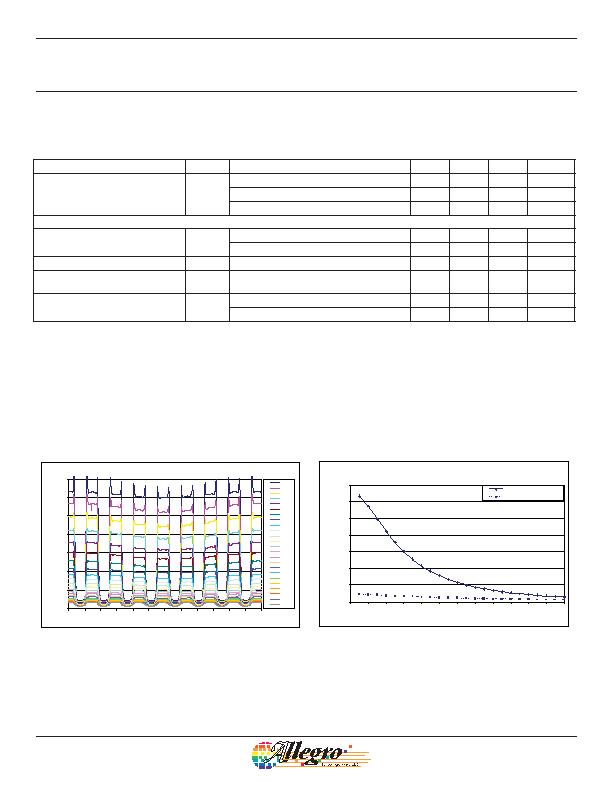
Programmable Back Biased Hall-Effect
Switch with TPOS Functionality
4
Allegro MicroSystems, LLC
115 Northeast Cutoff
Worcester, Massachusetts 01615-0036 U.S.A.
1.508.853.5000; www.allegromicro.com
ATS636LSE
MAGNETIC CHARACTERISTICS over operating voltage and junction temperature range using reference target; unless otherwise noted
Characteristics
Symbol
Test Conditions
Min. Typ. Max. Unit
Number of Programming Bits
Switchpoint
7
bit
Switchpoint Polarity
1
bit
Programming Lock
1
bit
Gear Tooth / Proximity Characteristics (Low switchpoint only)
Programming Air Gap Range
1
AG
Range
Temperature = 25癈, Code = 127
2.5
mm
Temperature = 25癈, Code = +127
1.5 mm
Programming Resolution
AG
Res
Temperature = 25癈 Program Air Gap = 2.5 mm 0.05
mm
Air Gap Drift Over Full Temperature
Range
2
AG
Drift
Device programmed to 2.5 mm
0.2
mm
Polarity
P
Over tooth (ATS636LSE)
Low
Over valley (ATS636LSE)
High
1
The switchpoint will vary over temperature. A sufficient margin obtained through customer testing is required to guarantee functionality over
temperature. Programming at larger air gaps leaves no safety margin for switchpoint drift. See the applications note Proximity Sensing
Programming Technique on the Allegro website at http://www.allegromicro.com for additional information.
2
The switchpoint will vary over temperature, proportionally to the programmed air gap. This parameter is based on characterization data and is not
a tested parameter in production. Switchpoint air gap generally drifts downward as temperature increases.
Tooth and Valley Field vs. Air Gap
Reference Target
0
200
400
600
800
1000
1200
1400
0.0 0.5 1.0 1.5 2.0 2.5 3.0 3.5 4.0 4.5 5.0 5.5 6.0
Air Gap [mm]
Reference Target Tooth
Reference Target Valley
Reference Target Tooth and Valley Field vs. Air Gap
Reference Target Flux Density vs. Position
0
200
400
600
800
1000
1200
1400
0 30 60 90 120 150 180 210 240 270 300 330 360
Position (?
0.25
0.50
0.75
1.00
1.25
1.50
1.75
2.00
2.25
2.50
2.75
3.00
3.25
3.50
3.75
4.00
4.25
4.50
4.75
5.00
5.25
5.50
5.75
6.00
Reference Target Flux Density vs. Position: Typical
发布紧急采购,3分钟左右您将得到回复。
相关PDF资料
ATS643LSHTN-I2-T
IC SENSOR GEAR TOOTH 4-SIP
ATS645LSHTN-I1
IC SENSOR GEAR TOOTH 4-SIP
ATS667LSGTN-T
IC SENSOR GEAR TOOTH 4SIP
ATS674LSETN-LT-T
IC SENSOR GEAR TOOTH 4-SIP
ATS682LSHTN-T
IC HALL EFFECT SENSOR 4SIP
ATS685LSHTN-T
IC HALL EFFECT GEAR SENSOR 4SIP
BU52001GUL-E2
IC HALL EFFECT SW BIPO VCSP50L1
BU52003GUL-E2
IC HALL EFFECT SW BIPO VCSP50L1
相关代理商/技术参数
ATS636LSB-FP
功能描述:IC SENSOR GEAR TOOTH 4-SIP RoHS:否 类别:传感器,转换器 >> 磁性 - 霍尔效应,数字式开关,线性,罗盘 (IC) 系列:- 标准包装:1 系列:- 传感范围:20mT ~ 80mT 类型:旋转 电源电压:4.5 V ~ 5.5 V 电流 - 电源:15mA 电流 - 输出(最大):- 输出类型:数字式,PWM,8.5 位串行 特点:可编程 工作温度:-40°C ~ 150°C 封装/外壳:20-SSOP(0.209",5.30mm 宽) 供应商设备封装:20-SSOP 包装:Digi-Reel® 其它名称:AS5132-HSST-500DKR
ATS636LSE
制造商:ALLEGRO 制造商全称:Allegro MicroSystems 功能描述:Programmable Back Biased Hall-Effect Switch with TPOS Functionality
ATS636LSE_12
制造商:ALLEGRO 制造商全称:Allegro MicroSystems 功能描述:The ATS636LSE programmable, true power-on state (TPOS), device is optimized Hall-effect IC and rare-earth pellet combinations that switch in response to magnetic signals...
ATS636LSETN
功能描述:IC SENSOR GEAR TOOTH 4-SIP RoHS:否 类别:传感器,转换器 >> 磁性 - 霍尔效应,数字式开关,线性,罗盘 (IC) 系列:- 标准包装:1 系列:- 传感范围:20mT ~ 80mT 类型:旋转 电源电压:4.5 V ~ 5.5 V 电流 - 电源:15mA 电流 - 输出(最大):- 输出类型:数字式,PWM,8.5 位串行 特点:可编程 工作温度:-40°C ~ 150°C 封装/外壳:20-SSOP(0.209",5.30mm 宽) 供应商设备封装:20-SSOP 包装:Digi-Reel® 其它名称:AS5132-HSST-500DKR
ATS636LSETN-T
功能描述:IC HALL EFFECT SWITCH TPOS 4-SIP RoHS:是 类别:传感器,转换器 >> 磁性 - 霍尔效应,数字式开关,线性,罗盘 (IC) 系列:- 标准包装:1 系列:- 传感范围:20mT ~ 80mT 类型:旋转 电源电压:4.5 V ~ 5.5 V 电流 - 电源:15mA 电流 - 输出(最大):- 输出类型:数字式,PWM,8.5 位串行 特点:可编程 工作温度:-40°C ~ 150°C 封装/外壳:20-SSOP(0.209",5.30mm 宽) 供应商设备封装:20-SSOP 包装:Digi-Reel® 其它名称:AS5132-HSST-500DKR
ATS-638194300
制造商:MOLEX 制造商全称:Molex Electronics Ltd. 功能描述:Hand Crimp Tool for Wire-to-Board Terminal, 28-30 AWG Wire for Loose Parts Only
ATS-638194400
制造商:MOLEX 制造商全称:Molex Electronics Ltd. 功能描述:A full cycle ratcheting hand tool ensures complete crimps
ATS-638230100
制造商:MOLEX 制造商全称:Molex Electronics Ltd. 功能描述:Hand Tool for 1.20mm Crimp Terminals, 30 AWG Wire for Reeled Product
